
Setting
Lys System
Lys is a 10.2 billion year old K-type star with five planets in the Triangulum Galaxy approximately, 2.8 milion lightyears away from the Solar System. It has a surface temperature of around 4780K, with a radius of 0.642 solar radii, and a mass of 0.77 solar masses. The star was discovered in 2107 by the New World Space Telescope, with the outer four planets discovered within the following decade using radial velocity measurements. The inner most planet (Tuonela) was discovered upon arrival in 2395.
A 10 year observation using the NWST led to the discovery of the four outer planets -- initially designated b, c, d and e -- with the inner two being within the star's habitable zone, which made the Lys System a canidate for the Far Field Expansion Project which was established in 2300. Preparations were made in 2384 to send roughly 2 million people to Lys with the trip taking roughly 10 years onboard using faster-than-light travel. The planets were given names upon arrival, starting from the inner-most: Tuonela, Imoto, Vista, Ukko and Odin. It was decided to settle on Vista due to concerns that the volcanic moon of Imoto, named Kazan, is polluting the atmosphere of Imoto and a risk to human health.
No considerations were made on the native life on Vista.
Lys
Lys is an orange dwarf of spectral class K4.7 and is considered a slightly metal-rich star with a radius 64.2% that of the Sun, and a mass 77% that of the Sun. It has a luminosity roughly 20% that of the Sun, and a roughly 9 year stellar cycle based on luminosity observatrions from the NWST. It is about 30000 lightyears away from the core of the galaxy and 125 lightyears away from NGC 592. No companion stars have been observed around Lys.
Measurements of Lys's roation yielded a 4.5 day rotation, which was refined to 4.2 days with further observations from arrival. Using the mass, luminosity and comopostion of the star, Lys has an estimated age of around 10.2 billion years old, and is estimated to exit main sequence in 9 billion years, significantly outlasting the solar system.
Lys has very ocasional flares (around 1 flare every 125 days) which can get large and complex based on initial observations from the NWST, but are not considered a hazard to life on Vista due to Vista's much stronger magnetic field, which is partly thanks to its large moon. The largest flare recorded to directly hit Vista was estimated to be X25.
The star has a strong mean magnetic field of around 2000 gauss.
Planetary system
Lys is orbited by five planets, named Tuonela, Imoto, Vista, Ukko and Odin going out from the star. They have orbital periods ranging from 17 to slightly over 2500 days, at distances of 0.12-3.5 astronomical units, making it a very distributed system.
Close observations have discorvered circumstellar dust disks between Vista and Ukko, and beyond Odin extending out to roughly 6 astronomical units. Comets and asteroids have been observed around the system, with some coming from the outer disk. Several dwarf planets were observed upon arrival and with later observations.
The inclination of the orbits relative to the system's ecliptic are within 1.5 degrees and are very circular with low eccentricities, with an exception for Odin which has an unusually high eccentricity of 0.2, which could be the result of previous orbital perturbation from Ukko in the early stages of the system's formation. None of the planets transit Lys from the perspective of the Solar System.
> Habitable zone
Because Lys is dimmer than the Sun, the habitable zone is located closer to the star. Two planets are located in the habitable zone, which includes Imoto and Vista. None of the planets are tidally locked to Lys, excluding Tuonela due to its proximity to the star. Its suggested that the habitable zone used to be closer to the star during its early phase in life and slowly expanded as it entered its main sequence phase. It is unknown whether Vista was frozen over during this period or maintained its liquid water, and its thought that Imoto used to be very similar to Earth during this time of lower heat from Lys.
> Skies and stellar light
Because Lys emits more infrared light than the Sun, there is less visible light on the planets' surfaces and may be as bright as a very cloudy day. Ignoring atmosphereic effects, illumination would be very slightly yellow. From Vista, Lys would take up 0.778° of the sky which is slightly larger than viewing the Sun from Venus. It has been observed that Imoto is very visible in the sky from Vista during sunrise and sunset, and even occasionaly in daylight due to their very close orbits, and transits in front of Vista approximatly every 234 days.
> Formation History
It is thought that the outer two terrestrial planets formed roughly where they are today with minimal planetary migration, and began forming in a very similar way to that of the solar system. Tuonela has been thought to have formed further out, and migrated inwards later on due to presence of volatiles at the poles, which would not have been present if it had formed closer to the star where most if not all the volatiles would have been boiled off. One theory suggests that Tuonela was struck by a proto-planet which caused a decrease in orbital velocity and started Tuonela's migration inwards. This theory is further supported due to Tuonela's large core which could be the result of the proto-planet stripping the top layers off Tuonela, leaving the core mostly intact. A possible debris disk has also been detected between Tuonela and Imoto which further supports this theory. It is also noted that Odin has a highly eccentric orbit, which could be the result of previous gravitational interactions between Ukko or a third gas giant which is no longer within the system.
List of planets
> Tuonela
Tuonela has a semi-major axis of 0.118 astronomical units and an orbital period of almost exactly 17 Earth days. It is tidally locked to its star and is outside the habitable zone and has a temperature of roughly 567K on the sun-facing side. Tuonela has a radius and mass roughly 0.735 and 0.327 that of Earth respectively, giving it a slightly lower density than Earth. It does not have any significant atmosphere due to its size, but does have a tenous unstable exosphere containing hydrogen, helium, oxygen and several metals and volotiles. Water ice reflects radar strongly, and ground observations from Vista has shown strong eveidence for water ice at the poles of Tuonela based on detected patches of high radar reflection at the poles. Later observations have also detected a magnetosphere around Tuonela roughly 2-3% that of Earth's.
> Imoto
Imoto has a semi-major axis of 0.358 astronomical units and orbits its star every 89.1 days. It is not tidally locked to Lys. Imoto has a radius and mass roughly 0.768 and 0.39 that of Earth respectively. It has a atmosphere containing nitrogen, oxygen, water vapor and other trace gases and a surface pressure of 1.6 atmospheres which helps distribute heat even across the surface and has a surface temperature of around 360K at the equator and 160K at the poles. Water has been observed on the surface of Imoto, with the largest body of water being slighly larger than China. Signs of life have been detected on Imoto, and it is suggested to only exist within the bodies of water and the upper atmosphere. Imoto also has a very active volcanic moon named Kazan orbiting about 27000 km from it, which also has possible signs of life in its thick sulfur and carbon dioxide rich atmosphere. Due to tidal interactions between Imoto and Kazan, both bodies are very volcanically active with major eruptions on Imoto and Kazan deteced every 200-300 days.
> Vista
Vista has a semi-major axis of 0.448 astronomical units and an orbital period of 125 days. It rotates roughly every two Earth days and has a tilt of aorund 30.2°. Vista has a radius and mass roughly 0.92 and 1.1 that of Earth respectively. It has an atmosphere with a surface pressure slightly more than Earth and a surface temperature of 290K at the equator and 185K at the poles. 81.2% of the surface is covered in oceans with a maximum depth of around 15 km, surpassing the depth of the Mariana Trench. Tectonic activity is very present on Vista with quakes being detected, and mountain formations with the highest peak being 10.4 km. Multi-celluar life has been observed on Vista on land, sea and air, but have been driven to near extinction due to human expansion. Vista also has a moon named Laken with some active volcanos and is slightly larger than the Moon and orbits Vista at a distance of around 120000 km every 4.9 days. Vista was home to roughly 3 million people before they had to be evacuated due to the WR2 Event.
> Ukko
Ukko is an ice giant about half the size of Juptier orbiting with a semi-major axis of 1.62 astronomical units and an orbital period of 855 days. It has a rotational period slightly over 7 hours, and a hydrogen rich atmoshpere with helium, methane and water vapor. It has an average temperature of around 133K. Ukko has three major moons -- designated Chisai, Churai and Oki going outwards -- in a 1:2:4 orbital resonance, with 75 other confirmed moons around Ukko. Ukko also has a very strong magentic field which has shown to heavily degrade electronics over short periods of time, hence Chisai and Churai have not been studied up close. All three major moons are suspected to harbor a subsurface ocean at least 2 kilometer thick, with gysers observed near Oki's south pole. Oki's emmisions have formed a very faint ring several hundered kilometers wide.
> Odin
Odin is an ice giant and the furthest known planet in the Lys system, and orbits Lys at a semi-major axis of 3.37 astronomical units, taking just over 7 years to complete an orbit. Odin has a high eccentricity of 0.2, meaning its distance to the star varies from 2.69 to 4.04 astronomical units. It has a rotational period of about 17 hours and, similar to Ukko, has a hydrogen rich atmosphere. Its temperature is around 90K. It has two major moons in a 1:2 orbital resonance with 102 other confirmed moons.
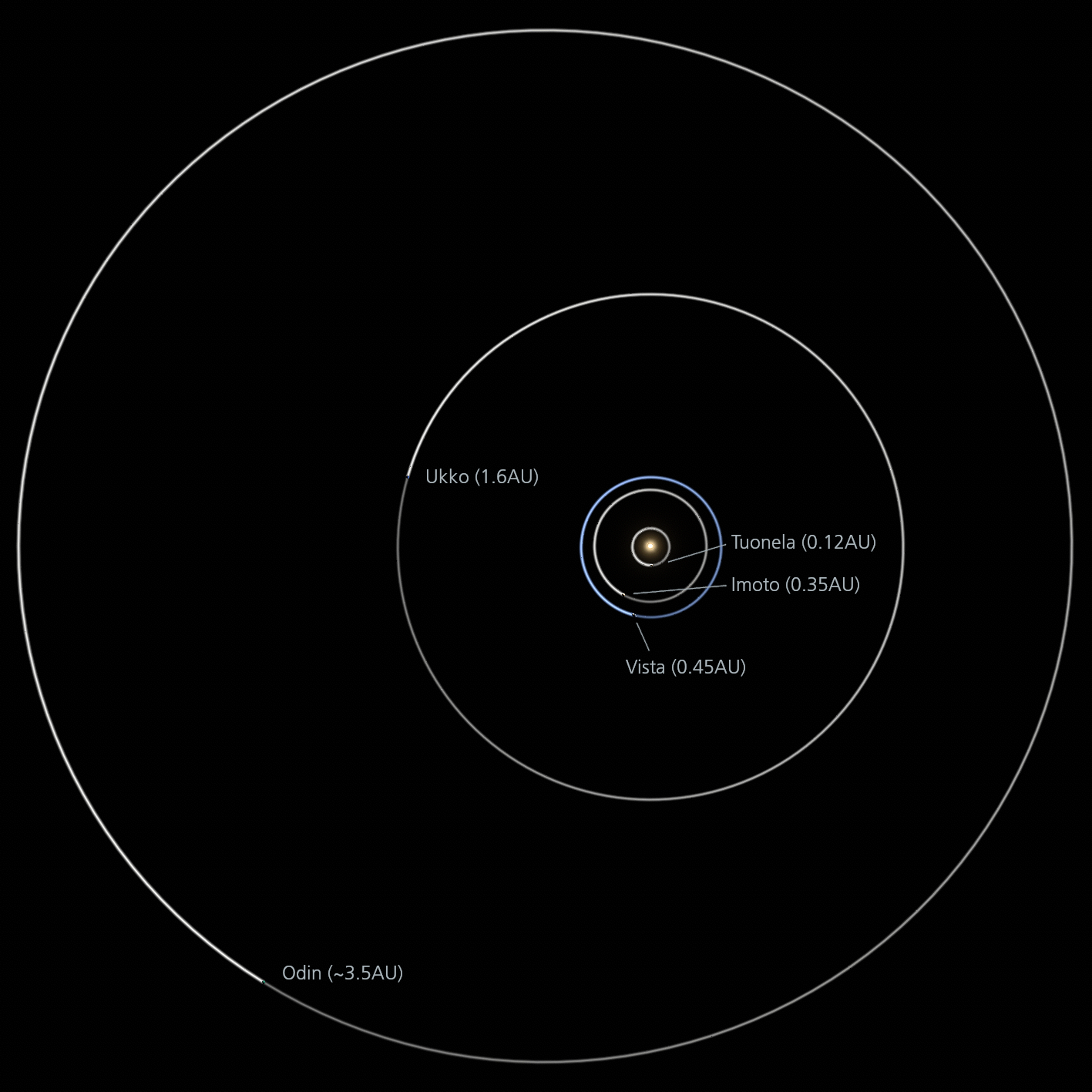

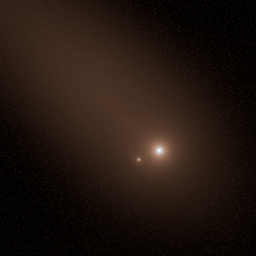
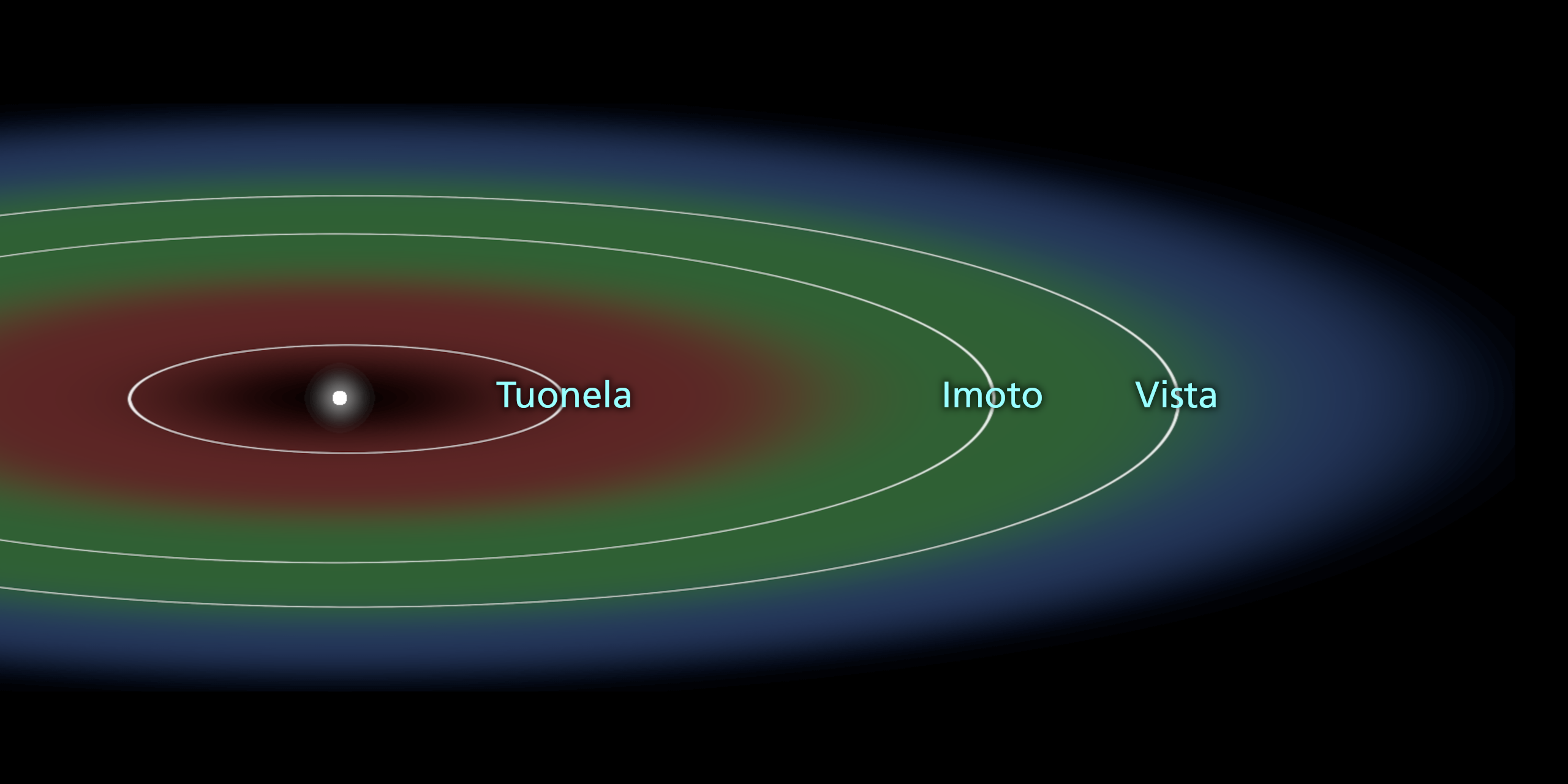
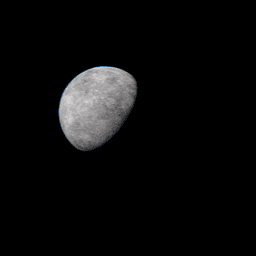
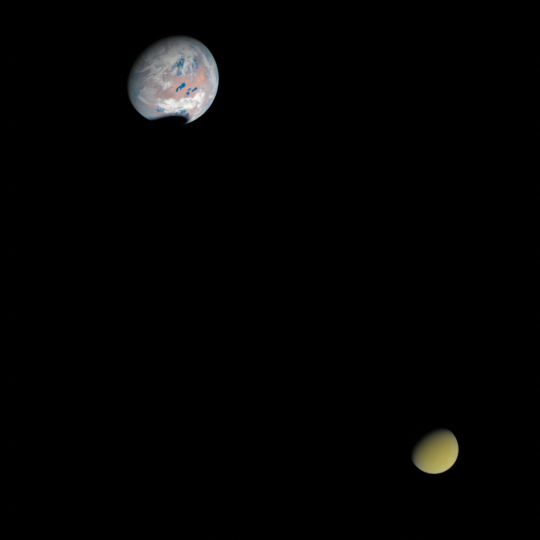
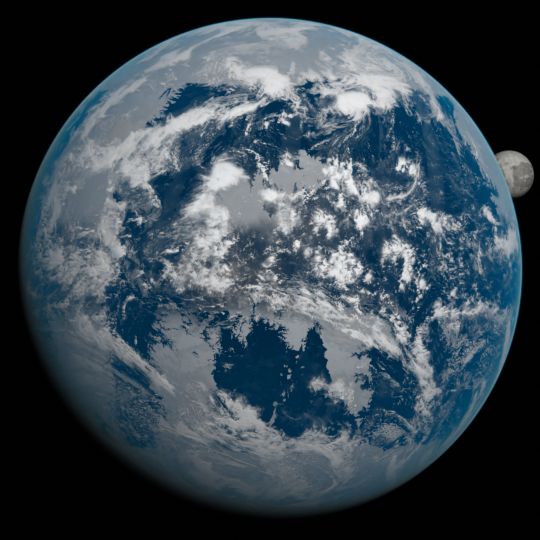
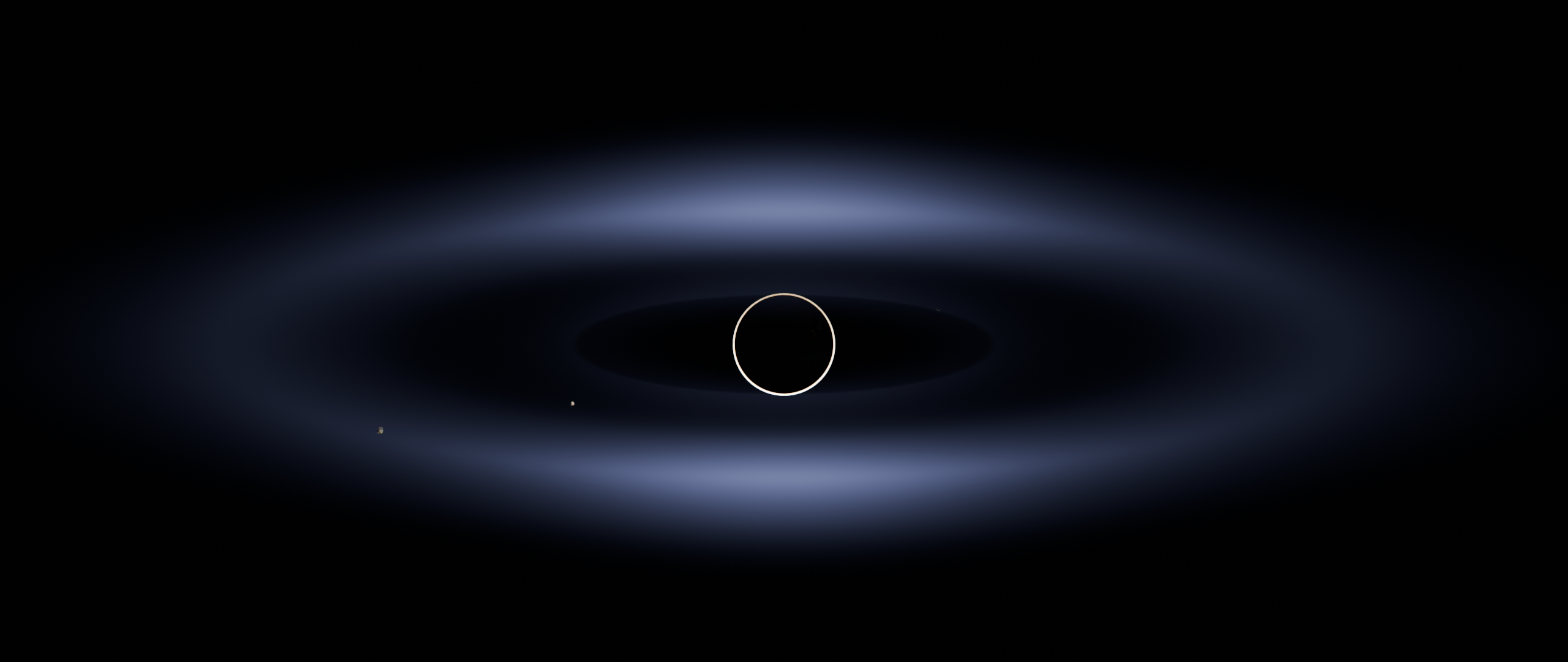

 Iris
Iris Taiga
Taiga